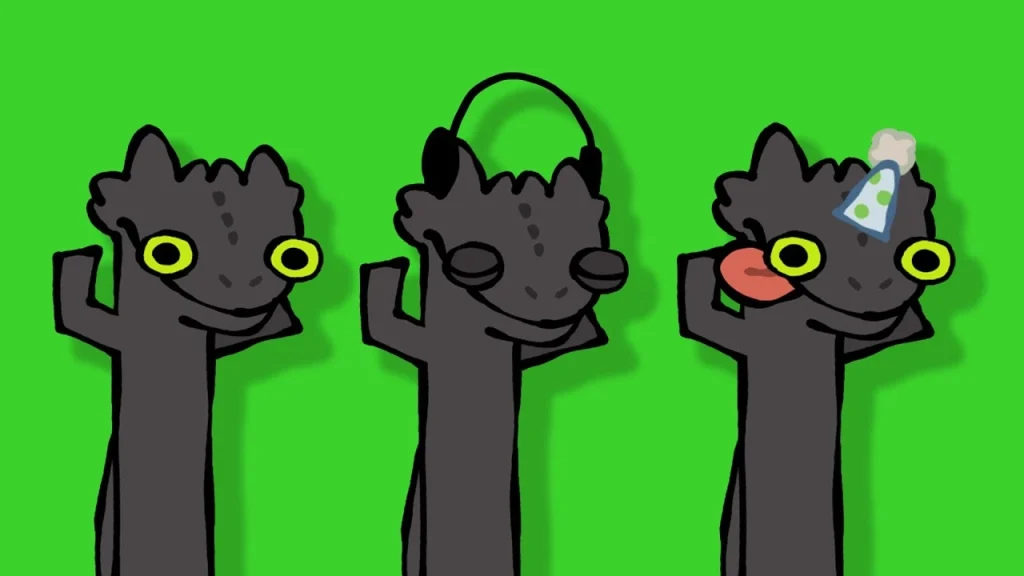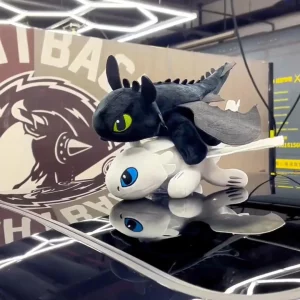The Toothless Dancing Meme is a short fan-made animation that shows Toothless, the dragon from How to Train Your Dragon, dancing to the Pokémon Driftveil City theme. The upbeat rhythm and playful moves turned a movie character into a viral TikTok and Instagram trend.
Animator Cas van de Pol created the clip for a parody recap video. He removed Toothless’s wings to make the dance more visible and increase comedic impact. The result is a looping sequence with exaggerated movements that amplify the dragon’s charm.
This pop culture mashup—DreamWorks animation paired with Nintendo music—spread quickly. Viewers began using green‑screen edits to place Toothless in different backgrounds. TikTok users merged the dance into challenges, while meme creators added remixes and alternate music tracks.
Within weeks, the meme evolved into a recognizable internet icon. Its appeal comes from three factors:
- Nostalgia for both How to Train Your Dragon and Pokémon
- Simplicity that works across short‑form video platforms
- Adaptability that lets creators insert the dragon into endless new scenarios
The Toothless Dancing Meme is more than a quick laugh—it’s a format that bridges movie fans, gamers, and online content creators.
The Origin Story
The Toothless Dancing Meme started with a parody video titled “The Ultimate ‘How To Train Your Dragon’ Recap Cartoon”, created by animator Cas van de Pol. In a short sequence, Toothless dances to the Pokémon Driftveil City theme. The upbeat soundtrack adds a nostalgic hook for fans of Nintendo games.
The animation is simple and expressive. Toothless’s large head, big eyes, and side‑to‑side steps create comedic appeal. Van de Pol removed the wings so the dance moves stayed fully visible and the humor stayed focused. Without wings, Toothless appears more like a cartoon companion than a fearsome dragon.
After its release on YouTube, the clip spread quickly to:
- TikTok, where creators used it in dance compilations and challenges
- Instagram, where meme pages looped it for humor
- Reddit, where fans posted remixes and debated the funniest version
The crossover of two well-known franchises — How to Train Your Dragon and Pokémon — gave it instant shareability. Fans created their own edits, from green‑screen backgrounds to slowed “lofi” versions.
The meme soon became raw material for constant fan creativity. A few seconds of playful animation turned into weeks of viral content across multiple platforms.

Popular Variations and Adaptations
The Toothless Dancing Meme inspired fans to create multiple versions that kept the trend alive and fresh. Each adaptation adds a new spin on the original animation.
Main Variations
- Green Screen Edits:
Creators used the meme’s green screen format to insert Toothless into new settings. Backgrounds ranged from famous movie scenes to city streets, and even other viral memes. - Extended Cuts:
Some editors looped the dance or added extra steps. These longer versions work well for meme compilations and reaction videos. - Other Dancing Dragons:
Animators designed similar dances for other dragons and fantasy creatures. This widened the appeal to fans of animation and fantasy art. - 3D and Clay Models:
Hobbyists recreated Toothless’s dance in physical form using clay sculptures or 3D-printed figures. They filmed these miniature versions and shared them on social media. - Music and Visual Remixes:
Users swapped the soundtrack, added visual effects, or combined the clip with elements from other fandoms. This kept the meme relevant to different audiences.
Why These Adaptations Spread?
- A simple format makes editing easy for beginners.
- Cross‑fandom appeal connects movie fans, gamers, and meme communities.
- Endless remix potential encourages participation and sharing.
These variations show that the Toothless Dancing Meme is more than a single joke. It’s a flexible, creative template that fans can adapt in countless ways.
How to Use or Create Your Own Toothless Dancing Meme?
Making your own Toothless Dancing Meme is simple with the right tools and steps. Follow this clear process to join the trend and boost your chances of creating shareable content.
1. Select an Editing Tool
Choose software that matches your skill level:
- Beginner-friendly: CapCut or InShot for quick edits and built-in meme templates.
- Advanced: Adobe After Effects or DaVinci Resolve for full creative control.
2. Get the Source Clip
Download a green screen or transparent version of Toothless from the original animation. These files make it easy to change backgrounds without losing animation quality.
3. Change Backgrounds and Music
Insert Toothless into:
- Famous locations
- Scenes from other movies
- Trending internet videos
Swap the original song for a fitting alternative—upbeat for energy, slow for comedy, or remix tracks for crossover appeal.
4. Add Custom Elements
Enhance the clip with:
- On‑screen captions
- GIF-style stickers or emojis
- Extra animation frames for new dance moves
These touches give your meme a unique identity and help it stand out in social feeds.
5. Export and Publish
Save your file in formats suited for TikTok, Instagram Reels, YouTube Shorts, and Reddit. Post during high-traffic hours for better reach.
6. Join the Meme Community
Use targeted hashtags like #ToothlessDancingMeme, #DragonDanceChallenge, or #ViralToothless. Comment on other creators’ posts, duet popular clips, and participate in remix challenges to increase visibility.
Why This Process Works?
- Simple structure makes it easy for creators at any skill level to follow.
- Adaptability lets you match the meme to your humor, brand, or fandom.
- Community engagement boosts reach and encourages shares.
A few small creative changes can transform the classic Toothless dance into your signature viral clip.
Community and Fan Engagement
The Toothless Dancing Meme thrives because of its highly active fan community. On TikTok, Instagram, YouTube, and Reddit, thousands of fresh posts appear each day, keeping the meme visible and encouraging constant interaction. This steady stream of content ensures the dance remains part of trending conversations across platforms.
Hashtags such as #ToothlessDance, #DancingDragon, and #ToothlessMeme regularly rank in trending lists, giving fans an easy way to find, share, and remix videos. On Twitter, long threads highlight the most creative or humorous edits. TikTok users add their own duets, stitches, or themed challenges, while YouTube compilations collect the best variations for wider audiences.
The enthusiasm extends beyond screens. Fans gather at conventions or casual meetups to discuss and recreate the dance. Many produce physical versions by sculpting Toothless from clay or designing 3D‑printed models. These offline activities show the meme’s cultural reach and how it inspires creativity in both digital and physical formats.
For creators and marketers, joining these community spaces offers direct access to an engaged, responsive audience. Participation in trending hashtags, collaborations with other creators, and contributions to challenges can build visibility while strengthening connections with fans. This exchange of ideas and content keeps the Toothless Dancing Meme dynamic and fuels its ongoing popularity.
FAQs
Who created the original Toothless Dancing Meme?
The animation was created by Cas van de Pol as part of a fan recap video.
Why are Toothless’s wings missing in the meme?
The wings were removed to emphasize the dancing moves and add humor.
Can I use the meme for commercial purposes?
Use caution with copyright and trademark rules. Fan creations are generally safe for personal or non-commercial use. Always seek permission for commercial exploitation.
How can I make my own version of the meme?
Use video editing tools with transparent backgrounds and remix the music and visuals creatively.
What platforms are best for sharing this meme?
TikTok, Instagram Reels, YouTube Shorts, Reddit, and Twitter are prime platforms for meme virality.
